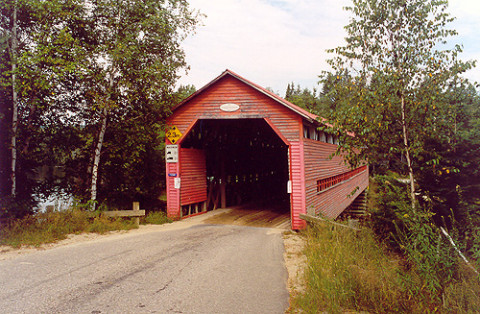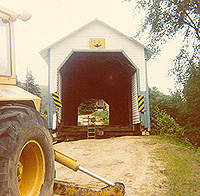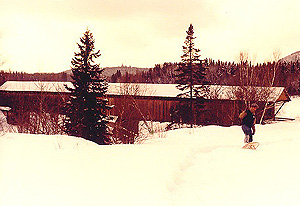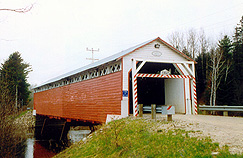
By the beginning of the 20th century, there were hundreds of covered bridges all across Quebec. Today the province numbers just over ninety, some built as late as the 1950s. In the Laurentians, there are six covered bridges, all in the Upper Laurentians, and all except one are well north of Mont Tremblant. In the heyday of the covered bridge, most villages had at least one; some had several. They dotted the back roads as well, crossing brooks and rivers of all sizes. Very few, however, have survived the ravages of time.
 THREATS TO COVERED BRIDGES
THREATS TO COVERED BRIDGES
Quebec’s harsh climate, arson, motor vehicle accidents, neglect, floods, vandalism, and replacement by modern structures, have all taken their toll. In recent decades, an alarming number of covered bridges have disappeared from the landscape. And many of the ones that do remain are in need of repair. Whether or not they survive depends largely on our desire to preserve them.
WHY A COVERED BRIDGE?
People have often speculated about why bridges were covered in the first place. Some believe that roofs were designed to provide travelers and their horses with shelter when it rained or snowed. Others think that the walls and a roof were there so that horses would not see the turbulent waters below. Folklore has it that sweethearts would rendezvous in covered bridges; hence the common nickname "kissing bridge." The real reason for covering a bridge with a roof and walls, however, was far less romantic. It was to protect the bridge's structure from the elements.
 A simple open bridge composed of beams ("stringers") and decking had a very limited life expectancy - perhaps ten or twenty years. After that the structure would begin to rot and sag. A bridge with a "truss" (a superstructure of interlocking timbers designed to support whatever weight was put upon the deck) would not only be much more solid, but would last longer as well.
A simple open bridge composed of beams ("stringers") and decking had a very limited life expectancy - perhaps ten or twenty years. After that the structure would begin to rot and sag. A bridge with a "truss" (a superstructure of interlocking timbers designed to support whatever weight was put upon the deck) would not only be much more solid, but would last longer as well.
Yet, although the sagging would be impeded, the elements would eventually still cause the bridge to rot. However, if the bridge were protected with a roof and walls, its life could be prolonged by as much as ten times that of an open span, whose timber beams, flooring, and trusses would be constantly exposed to the weather.
THROUGH THE CENTURIES
Covered bridges have existed for centuries. The oldest examples are in Europe, and date to the Middle Ages. The oldest in the world is thought to be Switzerland’s famous Kapellbrucke bridge, in Lucerne, built in the 1300s and recently ravaged by fire. Covered bridges may be found in Switzerland, Austria, Germany, the Czech Republic, Italy, and many other countries in Europe.Europeans who came to the New World in the 17th and 18th centuries are thought to have brought their bridge-building technology with them. As a result, covered bridges have been built in virtually every part of the United States (which today numbers about 800 of these structures), as well as in Quebec, Ontario, and the Maritimes.
 AMERICAN DESIGNERS
AMERICAN DESIGNERS
It was the Americans, in the 19th century, who truly perfected the science of the covered bridge. Throughout the 1800s, an array of inventors and engineers came up with an impressive repertoire of truss designs. They realized that the truss was the most important part of a bridge. The stronger the truss, the longer the covered bridge would last. Many of these men gave their names to their inventions: Moses Long, Herman Haupt, Theodore Burr, Peter Paddleford, William Howe, Willis Pratt, and Ithiel Town are some of the better known designers.
Reference:
1) Société québécoise des ponts couverts, Les Ponts Rouges du Québec, 1999, 9-10.
Click here for Part 2:
http://laurentian.quebecheritageweb.com/attraction/covered-bridges-laur…